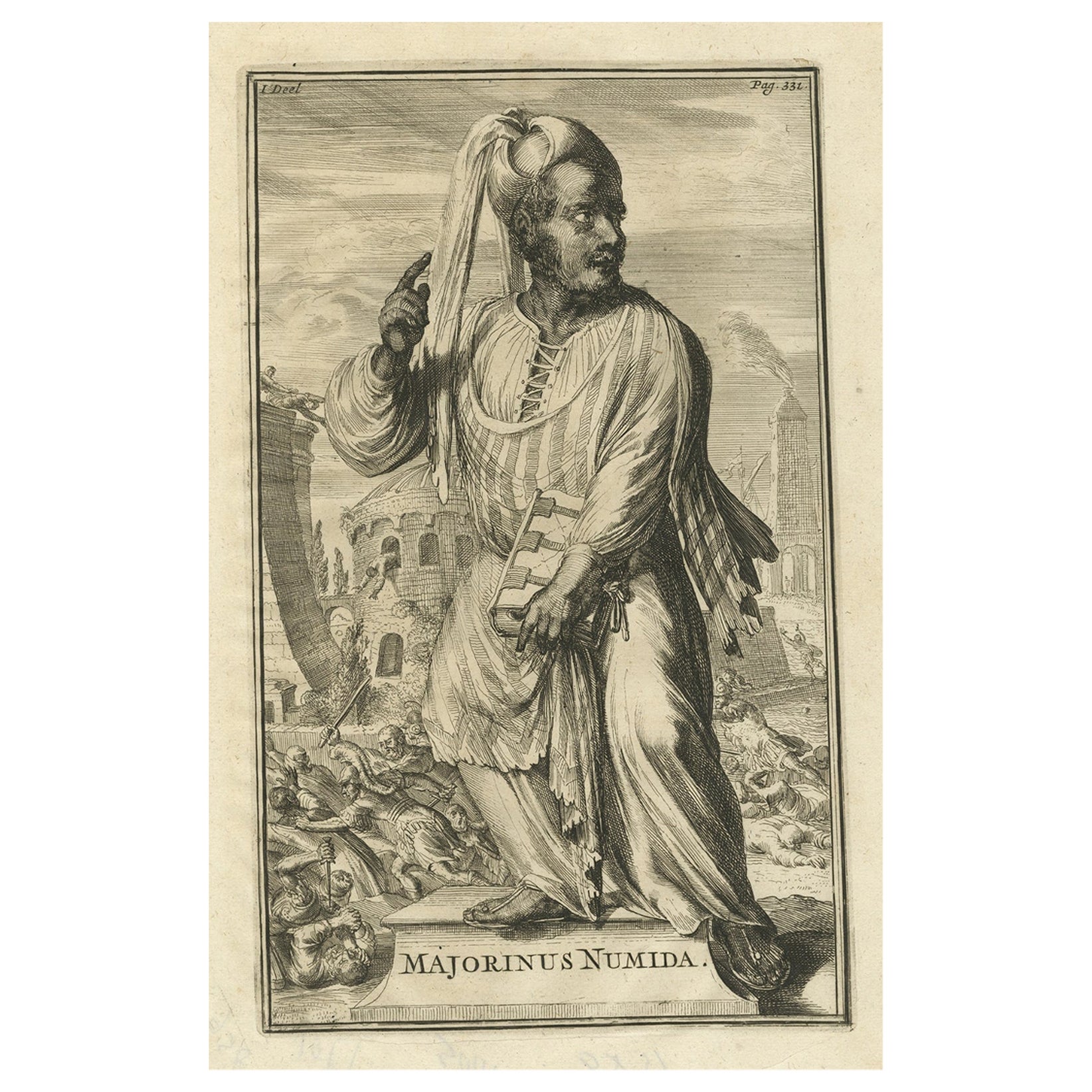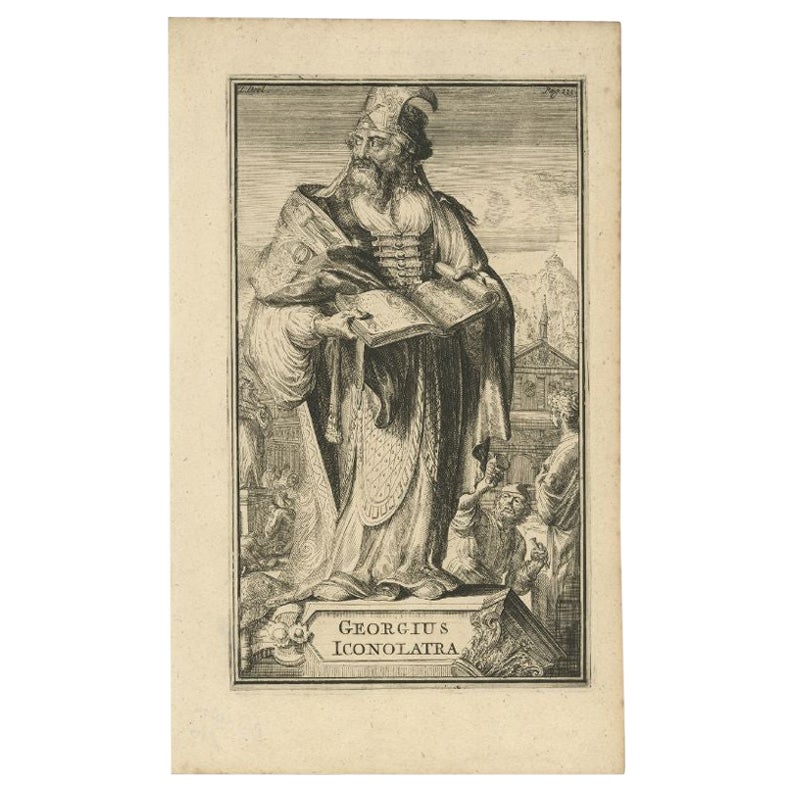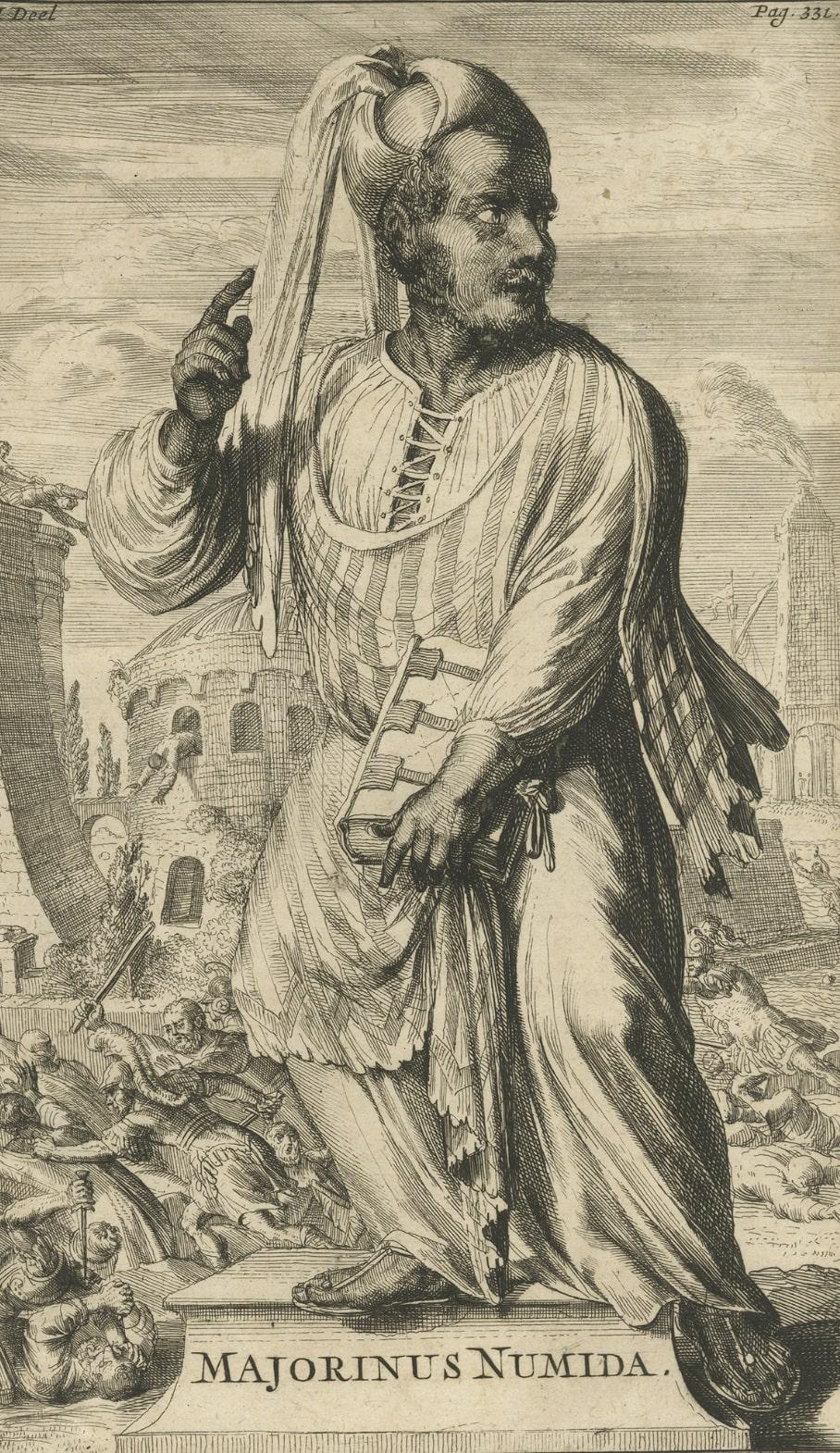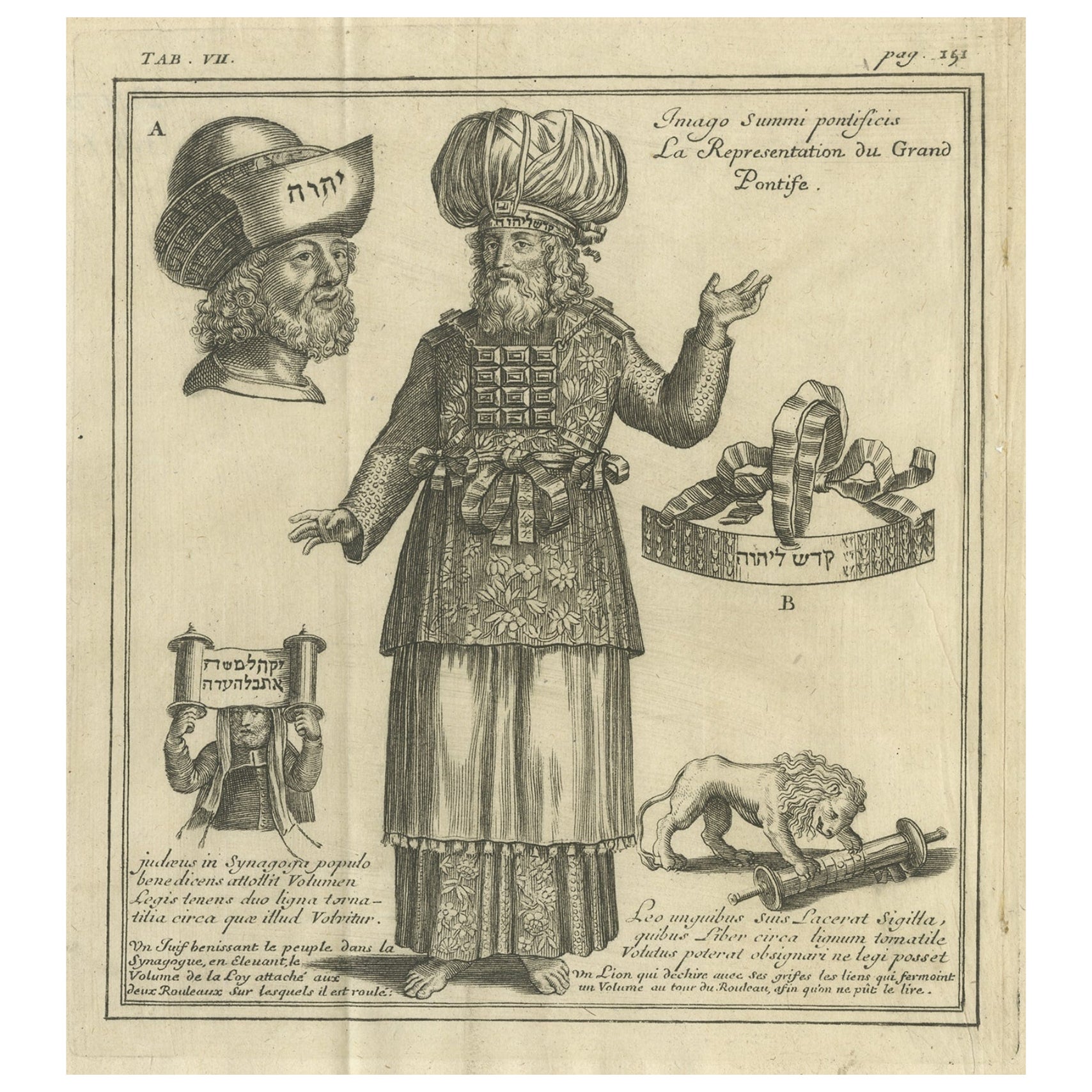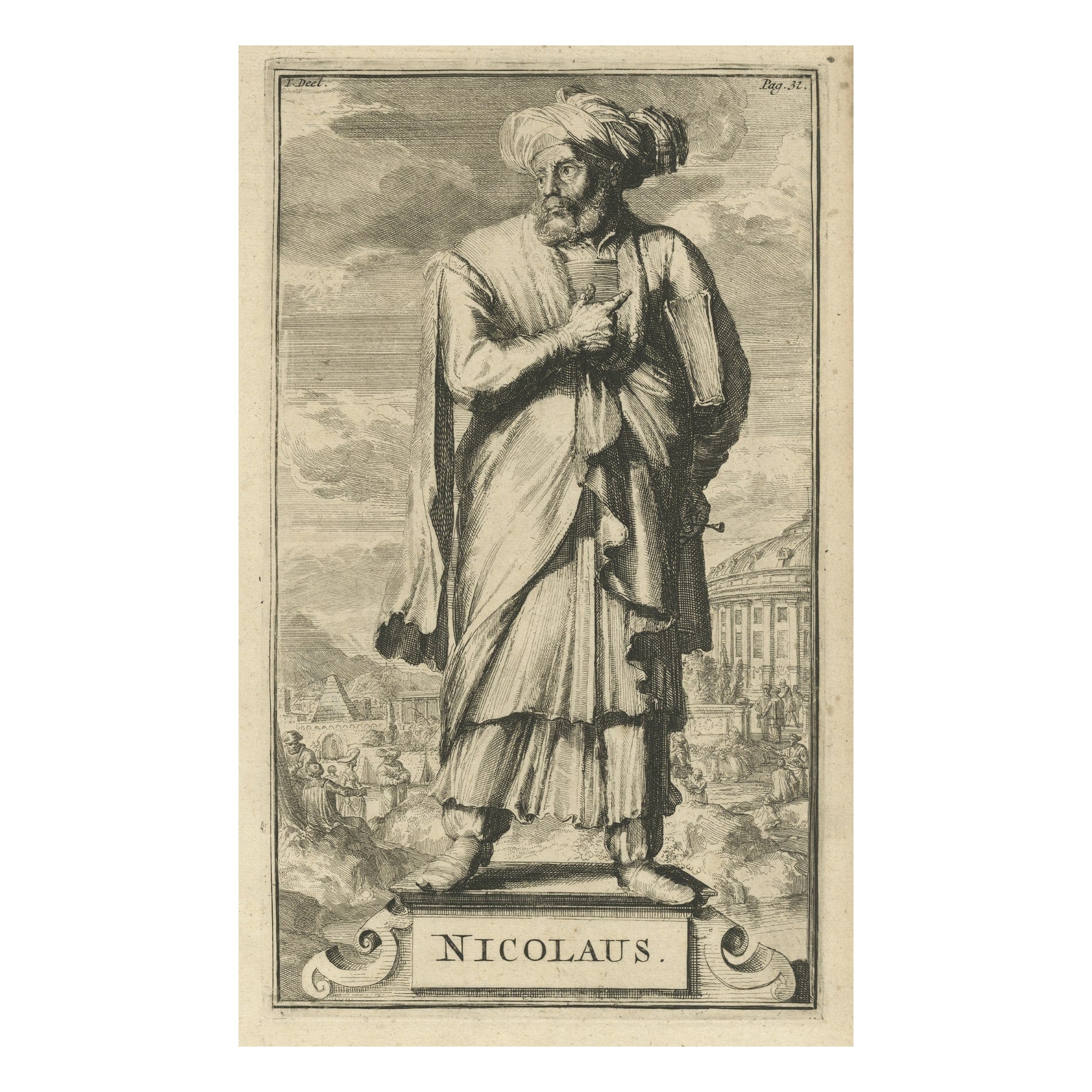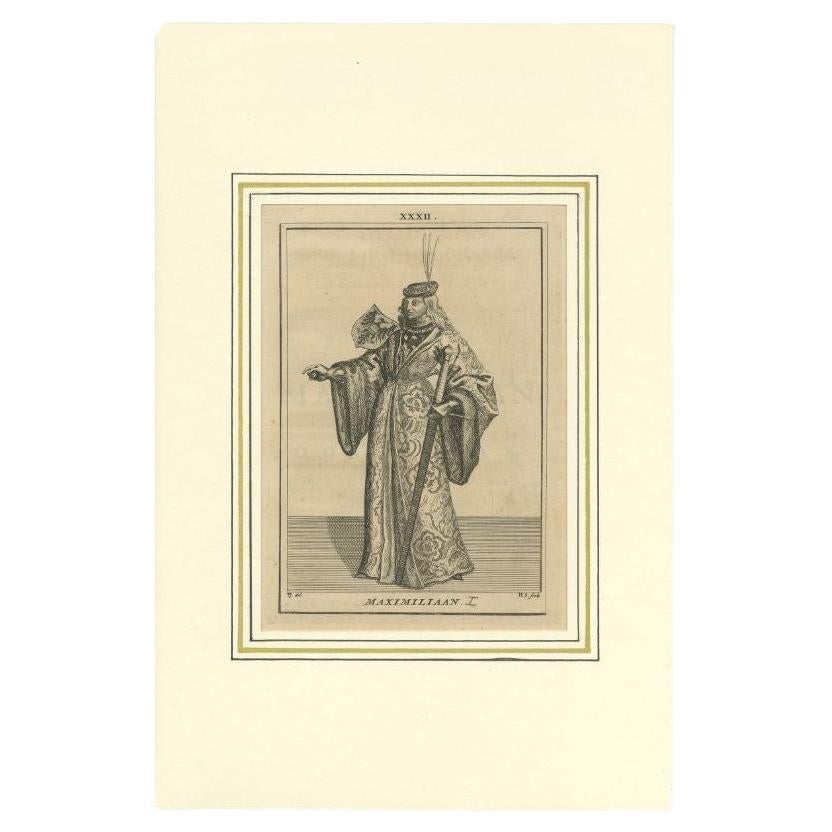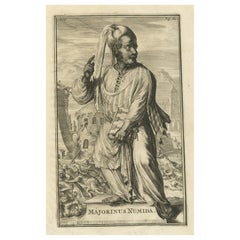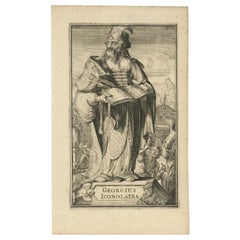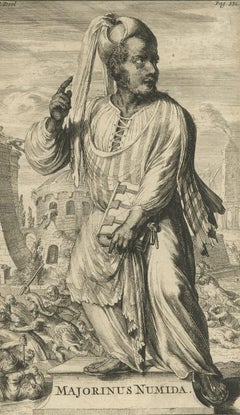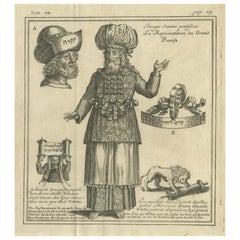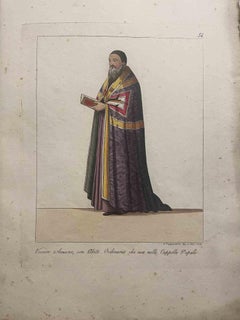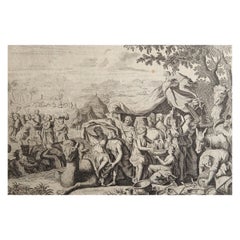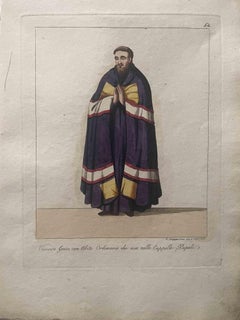Items Similar to Antique Print of Macedonius, a Greek Bishop of Constantinople, 1701
Want more images or videos?
Request additional images or videos from the seller
1 of 5
Antique Print of Macedonius, a Greek Bishop of Constantinople, 1701
$229.80
$287.2520% Off
£169.51
£211.8920% Off
€192
€24020% Off
CA$318.40
CA$39820% Off
A$345.72
A$432.1520% Off
CHF 183.08
CHF 228.8520% Off
MX$4,237.51
MX$5,296.8920% Off
NOK 2,265.72
NOK 2,832.1520% Off
SEK 2,140.99
SEK 2,676.2420% Off
DKK 1,461.67
DKK 1,827.0920% Off
About the Item
Antique portrait titled 'Macedonius'. Portrait of Macedonius I.
Macedonius (died after 360) was a Greek bishop of Constantinople from 342 up to 346, and from 351 until 360. He inspired the establishment of the Macedonians, a sect later declared heretical. This print originates from 'Historie der kerken en ketteren van den beginne des Nieuwen Testaments tot aan het jaar onses Heeren 1688 ... In het Neederduyts vertaald' by G. Arnold.
Artists and Engravers: Gottfried Arnold (1666 – 1714) was a German Lutheran theologian and historian. Etching by Romeyn de Hooghe.
Condition: Very good, general age-related toning. Please study image carefully.
- Dimensions:Height: 12.8 in (32.5 cm)Width: 7.49 in (19 cm)Depth: 0 in (0.02 mm)
- Materials and Techniques:
- Period:1700-1709
- Date of Manufacture:1701
- Condition:
- Seller Location:Langweer, NL
- Reference Number:Seller: BGI-00297 1stDibs: LU3054326622582
About the Seller
5.0
Recognized Seller
These prestigious sellers are industry leaders and represent the highest echelon for item quality and design.
Platinum Seller
Premium sellers with a 4.7+ rating and 24-hour response times
Established in 2009
1stDibs seller since 2017
2,622 sales on 1stDibs
Typical response time: <1 hour
- ShippingRetrieving quote...Shipping from: Langweer, Netherlands
- Return Policy
Authenticity Guarantee
In the unlikely event there’s an issue with an item’s authenticity, contact us within 1 year for a full refund. DetailsMoney-Back Guarantee
If your item is not as described, is damaged in transit, or does not arrive, contact us within 7 days for a full refund. Details24-Hour Cancellation
You have a 24-hour grace period in which to reconsider your purchase, with no questions asked.Vetted Professional Sellers
Our world-class sellers must adhere to strict standards for service and quality, maintaining the integrity of our listings.Price-Match Guarantee
If you find that a seller listed the same item for a lower price elsewhere, we’ll match it.Trusted Global Delivery
Our best-in-class carrier network provides specialized shipping options worldwide, including custom delivery.More From This Seller
View AllAntique Engraving of Majorinus, Bishop of Carthage of the Donatist Sect, 1701
Located in Langweer, NL
Antique print, titled: 'Majorinus Numida'
Majorinus was a bishop of Carthage in dispute with Ceacilianus. He favored the so-called Donatist sect. Het died ca. 329 AD. The background to the controversy was the wave of persecutions of Christians by the Roman Emperor Diocletian. At that time some Church leaders - unwilling to endure torture or death and become martyrs - had been ready to take such acts as worshipping the gods of the old pantheon, considered idols by Christians, or surrendering church books and property to the imperial authorities. Such people became known as 'traditors' ("surrenderers"). One of these "traditors", named Caecilian, had returned to the fold of the Church once the persecutions ended, and was consecrated Bishop of Carthage and Primate of North Africa. Those of the faithful who refused to accept the authority of such a spiritual leader raised Majorinus as a rival bishop; however, Majorinus died shortly after being consecrated, and it fell to Donatus to take his place and continue the struggle.
This rare print originates from: 'Historie der Kerken en Ketteren van den beginne des Nieuwen Testaments tot aan het Jaar onses Heeren 1688. Onzydig in 't Hoogduytsch beschreeven, door den Hoog-geleerden Heer Godfried Arnold, Voor deezen Hoog-Leeraar in de Historien tot Giesen. In het Neederduyts vertaald. Vercierd met verscheyde Koopere Plaaten door den Heer Romeyn de Hooghe.' (transl.: History of Churches and Heretics from the start of the New Testament until the year of our lord 1688 ...), by Godfried Arnold, Dutch edition published by Sebastiaan Petzold, Amsterdam 1701. This edition contains portraits of heretic figures, etched by the reknown Romeyn de Hooghe.
Artists and Engravers: Made by 'Romeyn de Hooghe' after an anonymous artist. Gottfried Arnold (pseud. Christophorus Irenaeus) was an important representative of the so-called radical Pietism, publicist, church historian and chants writer (so he was believed to have written the well-known Church song 'O Durchbrecher aller Bande'). Arnold studied theology in Wittenberg. From the Lutheran Orthodoxy he converted, through writings of Spener, to Pietism, associating later into a circle around the court preacher Sprögel, who was influenced by Jakok Böhm. Many medieval mystics were later re-issued by him. In addition he was clearly influenced by Grotius and the early enlightenment. His quest for the 'true' Christianity rightly brought him in the early Church. So he arranged an edition containing the sermons of the desert father Macarius. Arnold was a skilled patristicus, although he did not escape from the creation of an ideal image of the Christian life in the early Church, in his view a flowering time which ended with the reign of Constantine. His first study of the early Church ('Die erste Liebe der Gemeinen Jesu Christi') provided him a professor position in Gießen, a post which he soon left, disappointed by what he called the 'Ruhmsachtige Vernunftwesen des akademischen Lebens'. He continued as an individual scientist and he published books and poems. His main work is 'Unparteiischen Kirchen- und Ketzerhistorie' (1699-1700), of which this is the Dutch translation. He adapts in this study the reformatory decay theory, where the censure lies no longer with Constantine, but the post-Apostolic time. The decay is temporarily lifted with the Reformation, but occurres again soon, so that even the contemporary institutional Protestantism lies under the fire of his criticism. On the other hand he favours the 'Church of the spirit' that existed in all times (invisible) and is characterised by avoiding the world and asceticism. Not the orthodoxy, but the subjectivity of religious man...
Category
Antique Early 1700s Dutch Prints
Materials
Paper
$430 Sale Price
20% Off
Antique Print of George of Laodicea, the Bishop of Laodicea in Syria, 1701
By Romeyn de Hooghe
Located in Langweer, NL
Antique portrait titled 'Georgius Iconolatra'. Portrait of Saint George. George of Laodicea, a bishop of Laodicea, who was one of the principal champions of the homoiousian, or moderate Arian, theological position of the early Christian church. This print originates from 'Historie der kerken en ketteren van den beginne des Nieuwen Testaments tot aan het jaar onses Heeren 1688 ... In het Neederduyts vertaald' by G. Arnold.
Artists and Engravers: Gottfried Arnold (1666 – 1714) was a German Lutheran...
Category
Antique 18th Century Prints
Materials
Paper
$268 Sale Price
20% Off
Antique Print of Majorinus Numida, a Bishop of Carthage in Dispute, 1701
By Romeyn de Hooghe
Located in Langweer, NL
Antique portrait titled 'Majorinus Numida'. Portrait of Majorinus, a bishop of Carthage in dispute with Ceacilianus. He favored the so-called Donatist sect. He died ca. 329 AD. This print originates from 'Historie der kerken en ketteren van den beginne des Nieuwen Testaments tot aan het jaar onses Heeren 1688 ... In het Neederduyts vertaald' by G. Arnold.
Artists and Engravers: Gottfried Arnold (1666 – 1714) was a German Lutheran...
Category
Antique 18th Century Prints
Materials
Paper
$306 Sale Price
20% Off
Original Antique Engraving of A Jewish Priest, 1709
Located in Langweer, NL
Antique print titled 'La Representation du Grand Pontise'.
Old print depicting a Jewish Priest. This print originates from 'Introduction à l'écriture sainte, où l'on traite tout ...
Category
Antique Early 1700s Prints
Materials
Paper
$526 Sale Price
20% Off
Antique Print of Nicolaus, Christian Heresy, Published Ca. 1701
By Romeyn de Hooghe
Located in Langweer, NL
Antique portrait titled 'Nicolaus'. Portrait of Nicolaus (Nicolas). This print originates from 'Historie der kerken en ketteren van den beginne des Nieuwen Testaments tot aan het jaar onses Heeren 1688 ... In het Neederduyts vertaald' by G. Arnold.
Nicolaus – This original antique print depicts Nicholas. Nicolaism (also Nicholaism, Nicolationism, or Nicolaitanism) is a Christian heresy, first mentioned (twice) in the Book of Revelation of the New Testament, whose adherents were called Nicolaitans, Nicolaitanes, or Nicolaites. Hippolytus of Rome states that the deacon Nicolas was the author of the heresy and the sect. The Seven Deacons were leaders elected by the Early Christian church to minister to the people of Jerusalem. Nicholas, described in Acts as a convert to Judaism, was not remembered fondly by some early writers. According to Irenaeus’ Adversus Haereses, the Nicolaitanes, a heretical sect condemned as early as the Book of Revelation, took their name from the deacon.
Artists and Engravers: Gottfried Arnold (1666 – 1714) was a German Lutheran...
Category
Antique 18th Century Prints
Materials
Paper
$277 Sale Price
20% Off
Antique Print of Maximilian I, Holy Roman Emperor, 1745
Located in Langweer, NL
Antique print titled 'Maximiliaan'. Original print of Maximilian I. This print originates from 'De Graaven van Holland' by Pieter Langendijk. Published by...
Category
Antique 18th Century Prints
Materials
Paper
$210 Sale Price
20% Off
You May Also Like
Armenian Bishop - Etching by Giuseppe Capparoni - 1827
Located in Roma, IT
Armenian Bishop is an Artwork realized in 1827 by the Engraver, Giuseppe Capparoni (Rome 1800- 1879).
Etching hand colored on ivory paper. Signed on plate and dated on the right mar...
Category
1820s Modern Portrait Prints
Materials
Etching
Armenian Bishop - Etching by Giuseppe Capparoni - 1828
Located in Roma, IT
Armenian Bishop is an Artwork realized in 1828 by the Engraver, Giuseppe Capparoni (Rome 1800- 1879).
Etching hand colored on ivory paper. Signed on plate and dated on the right mar...
Category
1820s Modern Portrait Prints
Materials
Etching
Original Antique Print After Jan Luyken, Amsterdam, Genesis XXXI, 1724
Located in St Annes, Lancashire
Wonderful copper-plate engraving after Jan Luyken
Published by Marten Schagen, Amsterdam. 1724
Text on verso
The measurement given is the paper size.
Category
Antique 1720s Dutch Renaissance Prints
Materials
Paper
Greek Bishop - Etching by Giuseppe Capparoni - 1828
Located in Roma, IT
Greek Bishop is an Artwork realized in 1828 by the Engraver, Giuseppe Capparoni (Rome 1800- 1879).
Etching hand colored on ivory paper. Signed on plate and dated on the right margin...
Category
1820s Modern Portrait Prints
Materials
Etching
Original Antique Illuminated Print of St John Chrysostom. C.1880
Located in St Annes, Lancashire
Wonderful print of St John Chrystostom
Illuminated Chromolithograph
Published circa 1880
Unframed.
Free shipping
The measurement is the paper size
Category
Antique 1880s English Gothic Prints
Materials
Paper
Original Antique Print of An Arab Sheikh, 1817
Located in St Annes, Lancashire
Great image of an Arab Sheikh
Copper-plate engraving by T.Clerk
Published by Mackenzie And Dent. 1817
Unframed.
Category
Antique 1810s English Islamic Prints
Materials
Paper
